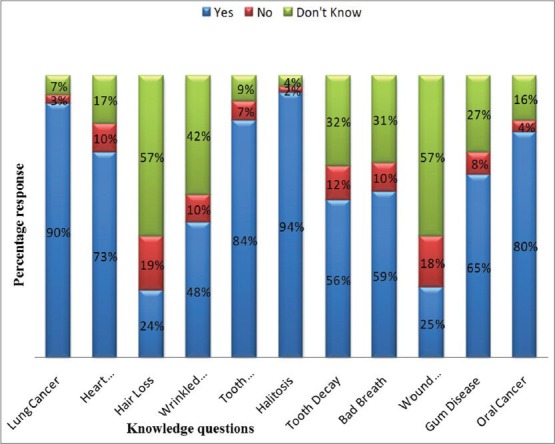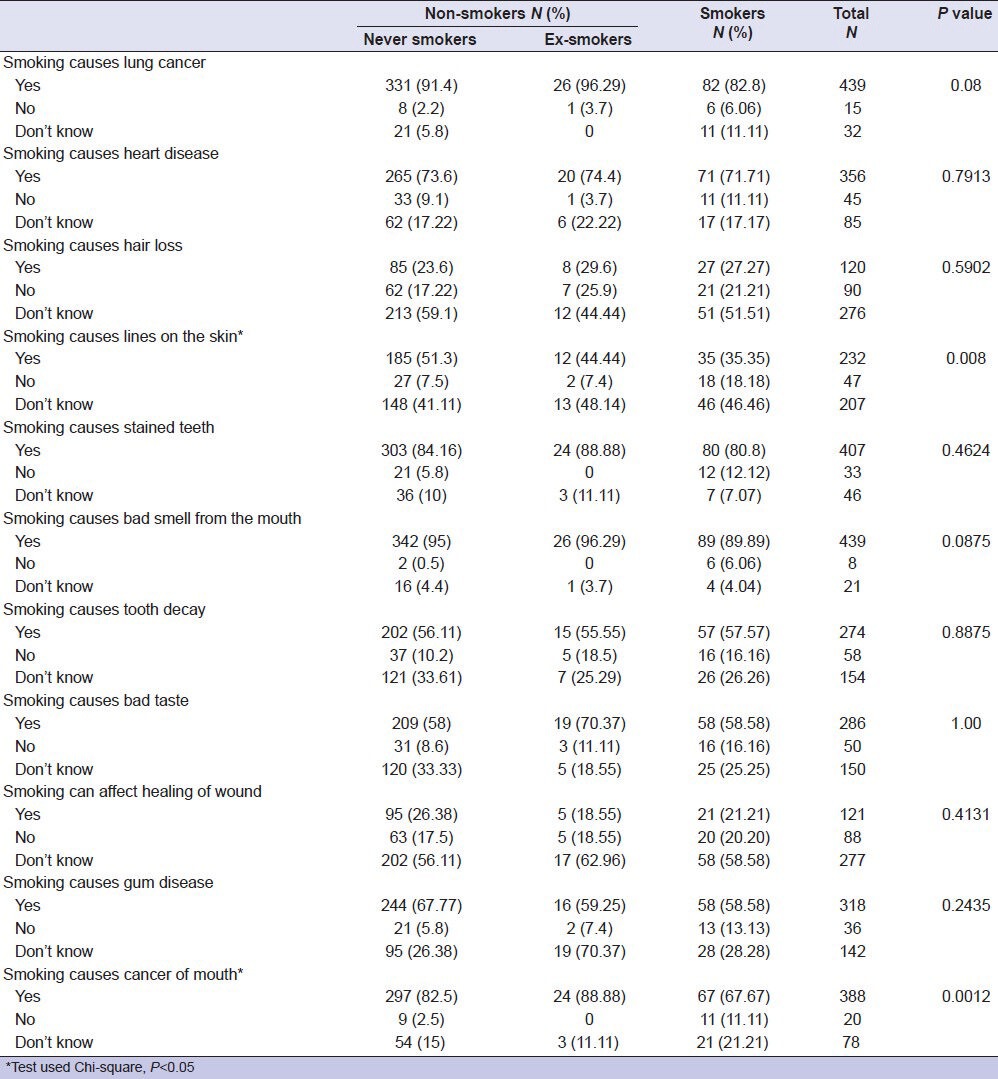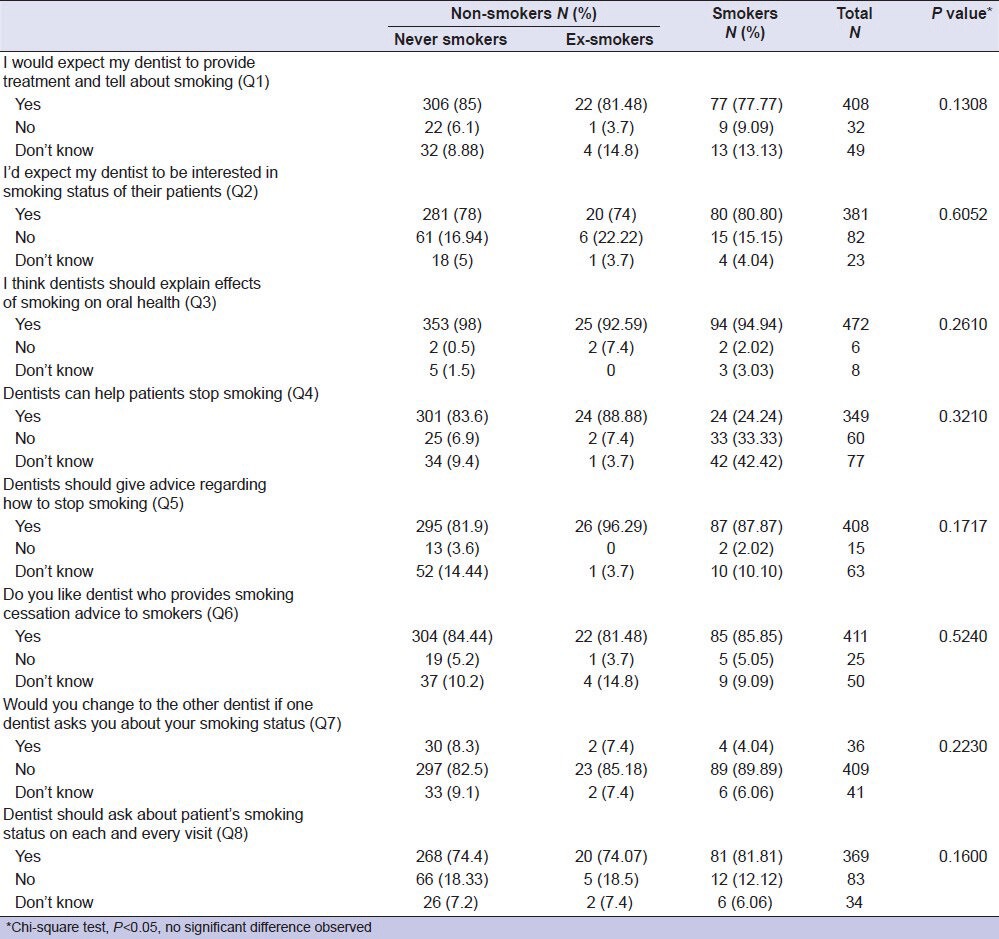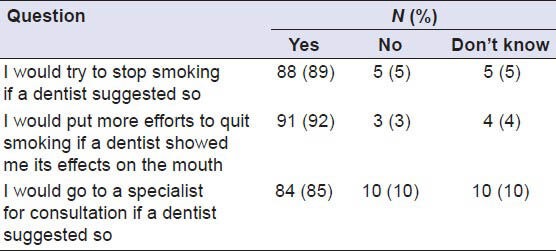Abstract
Objectives:
The objective of the following study is to assess the knowledge of patients about the consequences of smoking on the general and oral health, to analyze the patient's perceptions about the role of dentists in smoking prevention, counseling and cessation and to analyze the willingness of smokers to quit smoking following dentist's advice.
Materials and Methods:
A descriptive study was conducted in a sample of 486 dental patients visiting Vokkaligara Sangha Dental College and Hospital, Bengaluruin the month of August 2011 using a self-administered questionnaire. Descriptive statistics and Chi-square test was performed to analyze data.
Results:
The patients had good knowledge about the effects of smoking on general and oral health. Statistically significant difference was observed in the knowledge of smokers and non-smokers about the effects of smoking on ageing (P = 0.008) and oral cancer (P = 0.0012). Patients had a positive perception about the role of dentists in smoking cessation activities. Smokers exhibited a willingness to quit if suggested by the dentist.
Conclusion:
Patients perceive that dentists can play an important part in smoking cessation activities. Hence, dentists should not hesitate to give smoking cessation advice to their patients and grasp this opportunity to improve the general and oral health of the community.
Keywords: Knowledge, perceptions, prevention, smoking, smoking cessation
INTRODUCTION
Smoking is responsible for 100 million deaths world-wide.[1] The British doctors’ study has shown that smokers are reducing their life by an average of 7.5 years; irrespective of the type of tobacco smoked and the amount of daily smoking.[2] The negative effects of smoking on the general health of tobacco users are well-documented. It has been established as a risk factor for death from several systemic diseases including lung cancer, respiratory diseases and cardiovascular diseases.[3,4] It also causes premature hair graying, hair loss and skin ageing.[5,6,7,8] A large number of oral diseases and conditions such as staining of teeth and restorations, halitosis, impaired wound healing, periodontal diseases, failure of implants and surgical treatments, acute necrotizing ulcerative gingivitis and life-threatening precancerous and cancerous lesions are attributed to smoking.[9,10,11,12]
Southeast Asia especially India has one of the highest age adjusted incidence rates of oral cancer and upper aero-digestive tract cancers in the world.[13] According to World Health Organization the prevalence of tobacco habits in India is high with 34% using bidis, 31% cigarettes, 19% chewing tobacco, 9% hookah and 7% other forms respectively.[14] The cancer patients’ aid association of India revealed prevalence of cigarette use as 20%, bidis 40% and chewable tobacco 40%.[15] It has huge physical, mental, social and economic implications for our country. Already 1 in 5 of all adult male deaths and 1 in 20 of all adult female deaths at ages 30-69 are due to smoking and India will soon have 1 million smoking deaths a year.[16] By 2020 it is predicted to account for 13% of all deaths in India.[15] The direct medical costs of treating smoking tobacco attributable diseases in India have been estimated to exceed $900 million in 2004.[17] Families of smokers on average spend 3 times more on treatment of illness episodes compared with non-smokers. These families also reported 8 times increase in work days lost.[18] Moreover, the use of tobacco has been associated with impoverishment through borrowing and distress selling of assets due to costs of hospitalization.[19] Preventive strategies can play a pivotal role in reducing these implications.
The scope of preventive dentistry is constantly expanding and can be as far reaching as a professional's imagination, sense of responsibility and efforts. Dentists have been recognized as “ideally positioned to counsel against the use of cigarettes and smokeless tobacco products.”[3,13] They are one of the health professionals more frequently in contact with the general population and are first to see the effects of tobacco in mouth. They are as effective in providing smoking cessation counseling as any other health care professional.[20,21,22] The evidence is clear that smokers who receive assistance from health care workers are more successful at quitting than those without any support.[3,15,23]
Most of the studies in the past have focused on dentists’ or dental student's knowledge, attitude and practices regarding the various aspects of smoking and smoking cessation activities.[24,25,26] Very few studies have focused on patient's knowledge, awareness and perceptions regarding same.[27,28,29,30] Those available stress more on oral cancer rather than comprehensively covering all the aspects related to oral health and general health. There is a paucity of patient centered studies in the Indian scenario. Hence, the aim of the present study was to assess dental patients’ knowledge about effects of smoking, their perceptions regarding the role of dentists in smoking cessation interventions and willingness of smokers to quit smoking following dentist's advice.
MATERIALS AND METHODS
A descriptive study was conducted in August 2011 using a self-administered questionnaire.
Questionnaire development
The questionnaire was adopted from a previous study done by Terrades et al.[27] The face validity of the questionnaire was checked by 10 individuals who were not part of the study. The content validity was checked by a panel of eight experts. The content validity ratio was calculated using the formula given by Lawshe.[31] The value obtained for the present study was 0.88 which was above the minimum value of 0.85 for a panel of eight experts. The final questionnaire after modification consisted of three sections namely: Knowledge about effects of smoking on general and oral health (11 questions), perception of patients toward the role of dentist in smoking cessation and attitude towards smoking cessation counseling (eight questions) and smokers’ willingness to quit and consulting a specialist on dentists’ advice. The responses were recorded as yes, no and don’t know.
Study population and sample size
Study population consisted of patients visitingVokkaligara Sangha Dental College and HospitalBengaluru. A pilot study was conducted using the modified questionnaire on 50 patients to assess the operational feasibility of the study. Sample size was calculated using the standard formula seeking results at 95% confidence interval for which the value of z = 1.96 was fixed and the allowable error as 0.05 (e). Final sample of 486 was estimated.
Ethical clearance was obtained from Institution Review Board of Vokkaligara SanghaDental College and Hospital. Study sample was conveniently selected from the study population. Inclusion criteria consisted of subjects 18 years and above and ability to read questionnaire. Written informed consent was obtained from study subjects.
Data analysis
Descriptive statistics was used to analyze the data. Chi-square analysis was carried out to find association between knowledge, attitude of study subjects and response to the questions. P <0.05 was considered as statistically significant. The analysis was performed using SPSS 17.0 version software (SPSS Inc., Chicago, IL, USA).
RESULTS
The present study was a descriptive study conducted to assess perceptions of dental patients visiting Dental College and Hospital about smoking cessation as a part of oral health care delivery. All 486 subjects completed the questionnaire, with a response rate of 100%. Of 486 subjects, 311 (64%) were males and 175 (36%) were females. Majority (74%) of the study subjects were non-smokers.
Knowledge about effects of smoking on general and oral health
Figure 1 demonstrates patients’ knowledge about effects of smoking on general and oral health. It was assessed through a set of 11 questions. Overall patients had good knowledge about the relationship of smoking and cancer. However, they exhibited poor knowledge about its effect on hair loss and ageing. They were further categorized as smokers and non-smokers. The responses were further analyzed based on the smoking status of patients [Table 1]. Statistically significant difference (P < 0.05) was observed in the knowledge of smokers and non-smokers about the facts that smoking causes wrinkled skin (P = 0.008) and oral cancers (P = 0.0012). Non-smokers were more aware of the above facts.
Figure 1.

Knowledge of the patients about effects of smoking on general and oral health
Table 1.
Knowledge about effects of smoking on general and oral health depending upon smoking status

About the role of dentist in smoking cessation
Patients’ perceptions regarding the role of dentist in smoking cessation was recorded using a set of eight questions. Majority had positive perceptions about the role of dentist in smoking cessation activities [Figure 2]. No statistically significant difference was observed in the perception of smokers and non-smokers about the role of dentists in smoking prevention and cessation activities [Table 2].
Figure 2.

Perception of the patients about the role of the dentist in smoking cessation
Table 2.
Perceptions about role of dentist in smoking cessation according to smoking status

Smokers’ attitude towards smoking cessation counseling
Table 3 shows the positive attitude of smokers toward smoking cessation advice and referral. Majority (89%) smokers agreed to try to stop smoking if suggested by the dentist. They also (93%) agreed to put more efforts to quit smoking if the dentist showed its effect on the oral cavity. However, only 86% agreed to consult a specialist if suggested.
Table 3.
Response of smokers towards smoking cessation counseling

DISCUSSION
The present descriptive study assessed patients’ knowledge about the effects of smoking, perceptions about the role of the dentist and willingness of smokers to quit following dentists’ advice. Current smokers constituted only 20% of the study sample which was less compared to other studies.[27,32] The response rate for the present study was 100%. One of the reasons may be that the respondents were briefed about the study before filling the questionnaire and requested to complete it. Two of the researchers were also present while respondents filled the questionnaire.
Knowledge about effects of smoking on general health
Nearly 90% of the patients in the present study agreed that smoking causes lung cancer which is similar to that reported by Terrades et al.[27] and Rikard-Bell et al. studies.[29] The high knowledge may be because many campaigns and advertisements have focused on the smoking as a causative factor for lung cancer. The knowledge about the relationship of smoking and heart diseases was comparatively less compared to smoking and lung cancer with 73% of the patients agreeing that it causes heart disease. This may be because the direct effect of smoking on heart diseases is not very evident and other factors also play an important role. In other studies comparatively higher knowledge was reported.[27,29] Majority (52%) of the patients in the present study were not aware that smoking can cause hair loss, ageing and delayed wound healing. None of the previous studies to the best knowledge of authors have recorded this relationship in this context and scenario. Nearly 25% reported that smoking caused delayed wound healing which was in accordance with Al-Shammari et al. study.[30]
Knowledge about the effects of smoking on oral health
Patients in the present study demonstrated fairly good knowledge (76%) about the oral effects of smoking compared to its effects on general health. It was comparable to that reported by Lung et al.[28] (78%), however less as compared to 95% reported by Al-Shammari et al.[30] and Terrades et al.[27] Educational status, cultural beliefs and practices and attitudes vary from place to place. Tobacco chewing and smoking form part of cultural practices in many areas in India.[11] It may be responsible for less knowledge in the present pool of patients. The patients exhibited relatively less knowledge compared to other studies[27,28] when asked if smoking can cause tooth discoloration. However, knowledge regarding smoking and bad breath was similar to that reported by Terrades et al. study.[27] Only 59% believed that smoking caused bad taste from the mouth which was relatively less when compared with other studies.[27] For a non-smoker it may not be easy to appreciate this fact and smokers may become used to change in the taste and hence unable to appreciate it.
Patients’ knowledge regarding the relationship between smoking and dental caries was also explored in the present study. Majority (87%) agreed that smoking causes dental caries. Similar and conflicting results have been reported in other studies.[27,28,30] The relationship of smoking and dental caries is a controversial area of research. Recent research indicates that smoking creates favorable conditions for dental caries.[33,34,35] It has been demonstrated that cigarette smoke impairs salivary function and hence leads to dental caries. The patients might have agreed with the above fact as smoking was positively linked with the majority of other conditions. Nearly 65% patients in this study believed that smoking can cause gum diseases. Al-Shammari et al. and Terrades et al. reported relatively higher percentage (76% and 80% respectively).[27,30]
Nearly 80% patients agreed that smoking causes oral cancer, while 16% did not know the above fact. The knowledge about the oral cancer was comparatively good when compared to that reported by Rikard-Bell et al.[29] and Al-Shammari et al.[30] (74% and 62% respectively) and comparable to 85.5% reported by Terrades et al.[27] It is a cause of concern that in the present study still 16% of the patients were unaware that smoking can cause oral cancer despite the high incidence rates of oral cancer in our country.
In the present study, group statistically significant difference was seen in the knowledge of smokers and non-smokers about the relationship between smoking and ageing and smoking and oral cancers. Smokers exhibited less knowledge compared to non-smokers. These two areas concerning health can be highlighted while motivating the patients to quit smoking. Especially younger age group can be targeted to quit smoking by emphasizing its effect on the ageing process and esthetics. The overall knowledge of smokers and non-smokers was similar. It can be concluded that knowledge may not be the only reason to start and stop a habit. The other barriers need to be identified.
Role of dentist in smoking cessation
Both smokers and non-smokers had a positive perception about the role of dentist in smoking cessation activities. 83% of the patients believed that dentist should do health education apart from routine dental treatment. It was comparatively higher than 28% reported by Terrades et al.[27] and 58% reported by Campbell et al.[36] In the present study 78% and 97% patients believed that dentist should be interested in the smoking status of their patients and should explain about the effects of smoking on oral health respectively. This finding was comparable to 77% and 95% reported by Terrades et al.[27] and higher than 73% reported by Rikard-Bell et al.[29] 85% of the patients in the present study believed that dentists can help patients stop smoking and should advice how to do it compared to 60% reported by Terrades et al.[27] and 58.5% reported by Campbell et al.[36] 85% of the patients would appreciate dentists who provide smoking cessation advice. Similar findings were reported by other studies.[27] 84% of the patients would not shift to the other dentist if asked about their smoking status, whereas 79% reported this in Terrades et al.[27] and 60% in Rikard-Bell et al.[29] study. In the present study many patients felt it is embarrassing to tell about their smoking status, however, it was not the reason for the change of dentist. 76% of the patients in the present study feel dentists should ask about the smoking status of their patients’ on each visit. A similar finding was reported by Terrades et al.[27] Many patients feel that decision about quitting smoking is one's personal choice. Dentist should advice once or twice and should not ask again and again if a patient quitted smoking or not. Furthermore, many feel that asking about smoking status and quitting status may be embarrassing.
In the present study, both smokers and non-smokers consider that dentists can play an important role in smoking cessation activities. Hence dentists should not hesitate in educating patients about its effects. The health education and promotion in this aspect will not only help smokers quit smoking, but will also encourage non-smokers to abstain from this habit.
Smokers constituted only 20% (N = 99) of the study sample. Among these 89% agreed to try to quit smoking if suggested by a dentist. Similarly higher percentage of smokers showed the willingness to quit smoking (92%) and agreed to consult with specialist (85%) if suggested. The above results were similar to Terrades and Rikard-Bell et al. study.[27,29] It indicates that smokers believe dentist as an authority in smoking cessation activities and regard their suggestions.
Limitations
The present study reflects the perceptions of patients attending a dental hospital, so the results should be interpreted carefully as it may not reflect the perceptions of the general population. Also hospital setups encourage one to respond favorably. The presence of friends and relatives can have an effect on responses. The patients may not admit their actual smoking status in the presence of relatives or friends. The favorable responses may social desirability bias. Furthermore, the sample consisted of only 20% of the smokers which may have an effect on the responses.
CONCLUSION
It can be concluded from this study that the dental patients had a good knowledge about the general and oral effects of smoking. However, they had poor knowledge about the effects of smoking on hair loss, ageing and wound healing. They had a positive attitude toward the role of dentists in smoking cessation activities. Smokers exhibited a willingness to follow the dentists’ advice about quitting smoking. It is recommended to conduct such surveys among the general population covering different age groups. Dentists should inform their patients about the effects of smoking and strongly advice and help them in quitting and take up a more active role in such activities.
ACKNOWLEDGMENT
The authors would like to thank the participants who all participated in the study.
Footnotes
Source of Support: Nil.
Conflict of Interest: None declared
REFERENCES
- 1.Gallagher JE, Alajbeg I, Büchler S, Carrassi A, Hovius M, Jacobs A, et al. Public health aspects of tobacco control revisited. Int Dent J. 2010;60:31–49. [PubMed] [Google Scholar]
- 2.Doll R, Peto R, Hall E, Wheatley K, Gray R. Mortality in relation to consumption of alcohol: 13 years’ observations on male British doctors. BMJ. 1994;309:911–8. doi: 10.1136/bmj.309.6959.911. [DOI] [PMC free article] [PubMed] [Google Scholar]
- 3.Johnson NW, Bain CA. Tobacco and oral disease. EU-Working Group on Tobacco and Oral Health. Br Dent J. 2000;189:200–6. doi: 10.1038/sj.bdj.4800721. [DOI] [PubMed] [Google Scholar]
- 4.Fielding JE. Smoking: Health effects and control (1) N Engl J Med. 1985;313:491–8. doi: 10.1056/NEJM198508223130807. [DOI] [PubMed] [Google Scholar]
- 5.Trüeb RM. Association between smoking and hair loss: Another opportunity for health education against smoking? Dermatology. 2003;206:189–91. doi: 10.1159/000068894. [DOI] [PubMed] [Google Scholar]
- 6.Mosley JG, Gibbs AC. Premature grey hair and hair loss among smokers: A new opportunity for health education? BMJ. 1996;313:1616. doi: 10.1136/bmj.313.7072.1616. [DOI] [PMC free article] [PubMed] [Google Scholar]
- 7.Morita A. Tobacco smoke causes premature skin aging. J Dermatol Sci. 2007;48:169–75. doi: 10.1016/j.jdermsci.2007.06.015. [DOI] [PubMed] [Google Scholar]
- 8.Urbańska M, Nowak G, Florek E. Cigarette smoking and its influence on skin aging. Przegl Lek. 2012;69:1111–4. [PubMed] [Google Scholar]
- 9.Warnakulasuriya S, Dietrich T, Bornstein MM, Casals Peidró E, Preshaw PM, Walter C, et al. Oral health risks of tobacco use and effects of cessation. Int Dent J. 2010;60:7–30. [PubMed] [Google Scholar]
- 10.Erdemir EO, Sönmez IS, Oba AA, Bergstrom J, Caglayan O. Periodontal health in children exposed to passive smoking. J Clin Periodontol. 2010;37:160–4. doi: 10.1111/j.1600-051X.2009.01510.x. [DOI] [PubMed] [Google Scholar]
- 11.Chaly PE. Tobacco control in India. Indian J Dent Res. 2007;18:2–5. doi: 10.4103/0970-9290.30913. [DOI] [PubMed] [Google Scholar]
- 12.Johnson GK, Guthmiller JM. The impact of cigarette smoking on periodontal disease and treatment. Periodontol 2000. 2007;44:178–94. doi: 10.1111/j.1600-0757.2007.00212.x. [DOI] [PubMed] [Google Scholar]
- 13.Shah MN. New Delhi; India: WHO; 2005. Health professionals in tobacco control: Evidence from global health professional survey (GHPS) of dental students in India. [Google Scholar]
- 14.Geneva: WHO Publication; 1997. WHO. Tobacco or Health: A Global Status Report. [Google Scholar]
- 15.Shimkhada R, Peabody JW. Tobacco control in India. Bull World Health Organ. 2003;81:48–52. [PMC free article] [PubMed] [Google Scholar]
- 16.Jha P, Jacob B, Gajalakshmi V, Gupta PC, Dhingra N, Kumar R, et al. A nationally representative case-control study of smoking and death in India. N Engl J Med. 2008;358:1137–47. doi: 10.1056/NEJMsa0707719. [DOI] [PubMed] [Google Scholar]
- 17.John RM, Sung HY, Max W. Economic cost of tobacco use in India, 2004. Tob Control. 2009;18:138–43. doi: 10.1136/tc.2008.027466. [DOI] [PMC free article] [PubMed] [Google Scholar]
- 18.Sur D, Mukhopadhyay SP. A study on smoking habits among slum dwellers and the impact on health and economics. J Indian Med Assoc. 2007;105:492–6. 498. [PubMed] [Google Scholar]
- 19.Bonu S, Rani M, Peters DH, Jha P, Nguyen SN. Does use of tobacco or alcohol contribute to impoverishment from hospitalization costs in India? Health Policy Plan. 2005;20:41–9. doi: 10.1093/heapol/czi005. [DOI] [PubMed] [Google Scholar]
- 20.Beaglehole R, Watt R. London: Health Development Agency; 2004. Helping Smokers Stop: A Guide for the Dental Team. [Google Scholar]
- 21.Block DE, Block LE, Hutton SJ, Johnson KM. Tobacco counseling practices of dentists compared to other health care providers in a midwestern region. J Dent Educ. 1999;63:821–7. [PubMed] [Google Scholar]
- 22.Albert D, Ward A, Ahluwalia K, Sadowsky D. Addressing tobacco in managed care: A survey of dentists’ knowledge, attitudes, and behaviors. Am J Public Health. 2002;92:997–1001. doi: 10.2105/ajph.92.6.997. [DOI] [PMC free article] [PubMed] [Google Scholar]
- 23.Crail J, Lahtinen A, Beck-Mannagetta J, Benzian H, Enmarks B, Jenner T, et al. Role and models for compensation of tobacco use prevention and cessation by oral health professionals. Int Dent J. 2010;60:73–9. [PubMed] [Google Scholar]
- 24.Amemori M, Mumghamba EG, Ruotoistenmäki J, Murtomaa H. Smoking and drinking habits and attitudes to smoking cessation counselling among Tanzanian dental students. Community Dent Health. 2011;28:95–8. [PubMed] [Google Scholar]
- 25.Al-Qahtani D, Al-Qahtani M, Al-Qtaibi O, Al-Mobeeriek A. Repository, King Saud University; 2007. [Last accessed on 2013 Sep 16]. Dentists attitudes and practices regarding smoking cessation intervention and prevention in Riyadh, Saudi Arabia. Available from: http://www.hdl.handle.net/123456789/4111 . [Google Scholar]
- 26.Huang B, Inagaki K, Yoshii C, Kano M, Abbott PV, Noguchi T, et al. Social nicotine dependence in Australian dental undergraduate students. Int Dent J. 2011;61:152–6. doi: 10.1111/j.1875-595X.2011.00032.x. [DOI] [PMC free article] [PubMed] [Google Scholar]
- 27.Terrades M, Coulter WA, Clarke H, Mullally BH, Stevenson M. Patients’ knowledge and views about the effects of smoking on their mouths and the involvement of their dentists in smoking cessation activities. Br Dent J. 2009;207:E22. doi: 10.1038/sj.bdj.2009.1135. [DOI] [PubMed] [Google Scholar]
- 28.Lung ZH, Kelleher MG, Porter RW, Gonzalez J, Lung RF. Poor patient awareness of the relationship between smoking and periodontal diseases. Br Dent J. 2005;199:731–7. doi: 10.1038/sj.bdj.4812971. [DOI] [PubMed] [Google Scholar]
- 29.Rikard-Bell G, Donnelly N, Ward J. Preventive dentistry: What do Australian patients endorse and recall of smoking cessation advice by their dentists? Br Dent J. 2003;194:159–64. doi: 10.1038/sj.bdj.4809899. [DOI] [PubMed] [Google Scholar]
- 30.Al-Shammari KF, Moussa MA, Al-Ansari JM, Al-Duwairy YS, Honkala EJ. Dental patient awareness of smoking effects on oral health: Comparison of smokers and non-smokers. J Dent. 2006;34:173–8. doi: 10.1016/j.jdent.2005.05.006. [DOI] [PubMed] [Google Scholar]
- 31.Lawshe CH. A quantitative approach to content validity. J Pers Psychol. 1975;28:563–75. [Google Scholar]
- 32.Rad M, Kakoei S, Tabasi MF. Evaluation of knowledge, attitude and practice of dental patients of smoking effects on oral health. [Last accessed on 2014 Sep 02];J Isfahan Dent School. 2008 3:118–25. Available from: http://www.jids.mui.ac.ir/index.php/jids/article/view/82 . [Google Scholar]
- 33.Campus G, Cagetti MG, Senna A, Blasi G, Mascolo A, Demarchi P, et al. Does smoking increase risk for caries. A cross-sectional study in an Italian military academy? Caries Res. 2011;45:40–6. doi: 10.1159/000322852. [DOI] [PubMed] [Google Scholar]
- 34.Zitterbart PA, Matranga LF, Christen AG, Park KK, Potter RH. Association between cigarette smoking and the prevalence of dental caries in adult males. Gen Dent. 1990;38:426–31. [PubMed] [Google Scholar]
- 35.Jette AM, Feldman HA, Tennstedt SL. Tobacco use: A modifiable risk factor for dental disease among the elderly. Am J Public Health. 1993;83:1271–6. doi: 10.2105/ajph.83.9.1271. [DOI] [PMC free article] [PubMed] [Google Scholar]
- 36.Campbell HS, Sletten M, Petty T. Patient perceptions of tobacco cessation services in dental offices. J Am Dent Assoc. 1999;130:219–26. doi: 10.14219/jada.archive.1999.0171. [DOI] [PubMed] [Google Scholar]


